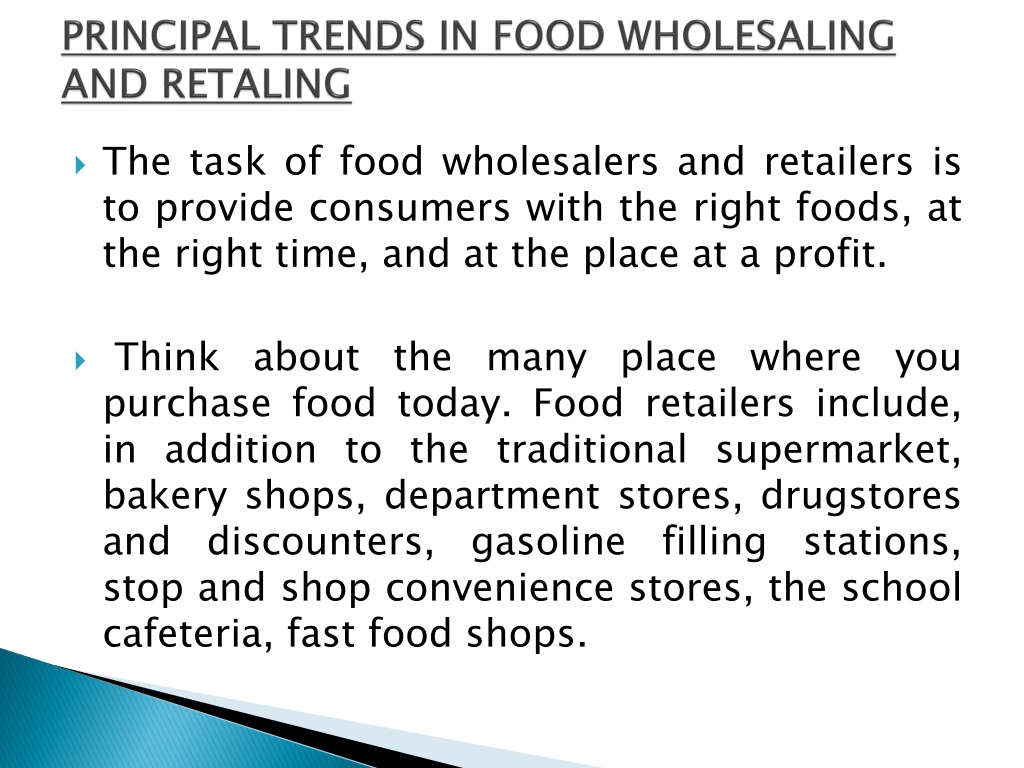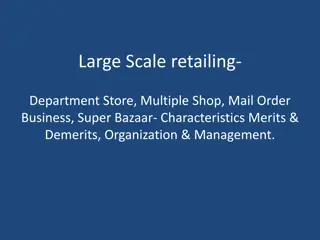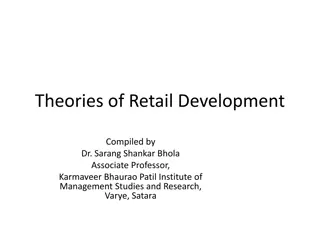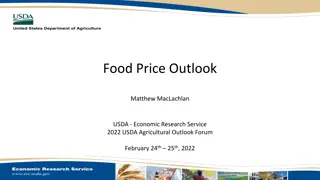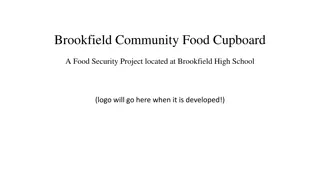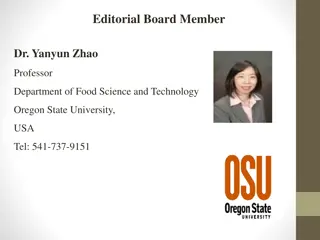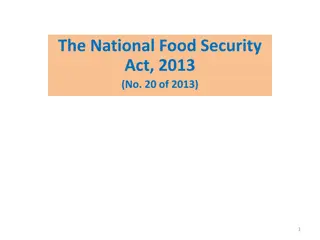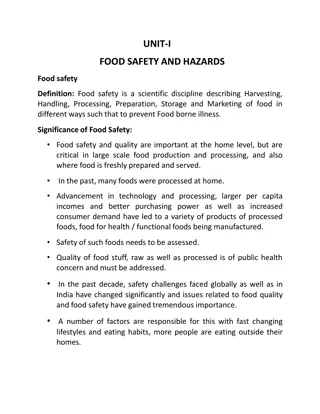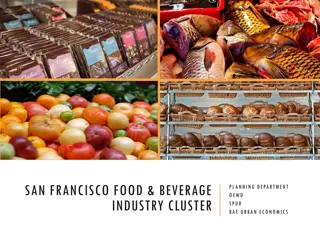Evolution of Food Retailing and Wholesaling Network
Food wholesalers and retailers play a crucial role in providing consumers with a variety of food products at different locations, reflecting changing consumer demands and competitive conditions. The network includes supermarkets, convenience stores, online shopping, and more, showcasing the evolution of how food is sourced and distributed to meet consumer needs efficiently.
Download Presentation

Please find below an Image/Link to download the presentation.
The content on the website is provided AS IS for your information and personal use only. It may not be sold, licensed, or shared on other websites without obtaining consent from the author. Download presentation by click this link. If you encounter any issues during the download, it is possible that the publisher has removed the file from their server.
E N D
Presentation Transcript
The task of food wholesalers and retailers is to provide consumers with the right foods, at the right time, and at the place at a profit. Think about the many place where you purchase food today. Food retailers include, in addition to the traditional supermarket, bakery shops, department stores, drugstores and stop and shop convenience stores, the school cafeteria, fast food shops. discounters, gasoline filling stations,
Food is never far away. Because of their close contact with consumers, food wholesaling and retailing firms are prime examples of how marketing agencies change in response to new demands and competitive conditions. The large super markets that handled a much wider variety of foods and nonfood items on a self service, cash and carry basis. This preferences, changes processors, wholesalers, and retailers. trend reflected competitive the changing pressures, relationships consumer and food in of
There are other changing signs of food retailing. Consider the shopper who notices that many food products can now be purchased at K- Mart, Wal-Mart, or wholesale club. Consumers are purchasing prepared foods for supermarket delicatessens. take out in convenience stores and Another busy family places food order by phone and has their food delivered weekly.
Retailer find consumer wants and fill them. The generally located in food production areas. wholesale assembly markets are The job of these shipping point markets is to assemble large lots of product from diverse producers shipment on to the processors or wholesalers located in the cities. and prepare the products for
Some farmers perform their own assembly market functions specialized firms. while others use the services of A complex processors, wholesalers, and retailers has evolved over time. network of relationships between For example, most food retailers are affiliated in some way with food wholesalers and many food retail firms also own processing facilities. By the same token, many food processors operate their own wholesaling operations. Though soled offices and branch warehouses, they deal directly with retail buyers.
Assembly Markets Shippers auctions Commission houses cooperatives Agents, brokers buying offices Food Processing Importers Jobbers, Agents Merchant Chain store Mfg. Sales Foodservice Exporters Purveyors Food Brokers Wholesalers Warehouses Offices, Wholesalers Nontraditional Stores Retail Food store Food Service *Department store *supermarkets *restaurants *Gasoline stations *convenience stores *institutions *specialized food stores * plants, offices *recreational places Fig: Structure of the wholesale-retail food distribution network
Some food processing firms also compete indirectly with retail grocery stores through the ownership of restaurants. Thus food processors, wholesalers, and retailers are expanding their activities beyond their functions traditional ranges of marketing
The food store sector of the food marketing system has experienced consider change over the years. The rise of the chain store, the development of supermarkets, the introduction of food discounters and convenience stores, the continual growth in variety of food products, and battle between national and private food labels have all left their mark on food retailing.
The number of food stores increased during the 1980s and 1990s with the growth of smaller, neighborhood convenience stores. The national chain stores operates in every city, and the large chain stores often do not meet head to head in every market. Food store concentration is often higher in smaller cities. Market generally lower than for food stores. concentration in foodservice is
Mergers, firm restructurings, and foreign investments are continuing to reshape the retail food industry. Most mergers involve food firms but non food firms sometimes merge with food retailers. In order to fully understand the contemporary structure and competitive behavior of food retailing, we must review two revolutions in this industry; the chain store movement and the supermarket movement.
Although the terms chain stores and supermarkets are used synonymously today. These two forms of food retailing developed quite independently and for somewhat different reasons. A grocery store is usually classified as a supermarket if its annual sales exceed $2 million it emphasizes service and features dairy meat, produce, and dry grocery departments. A chain store operation is a group of two or more related grocery stores. Chain stores may or may not be supermarkets and supermarkets may or may not be part of a chain store operation.
The modern food chain store operation represents both a horizontal affiliation of retail stores and a vertical affiliation of food retailing, wholesaling and often, processing activities. The chain store movement grew out of a search for operational efficiencies through large scale buying and selling and a drive for competitive market advantage among food retailers.
The origin of chain retailing is usually traced back to the establishment of the Great Atlantic and Pacific Tea Company in 1858. However, it was not until the decade of the 1920s that real growth occurred. By 1929, it was estimated that chain stores were doing about 38 percent of the total business of combination grocery and meat stores. At about this time. many food chains also reached their maximum number of outlets.
Originally collected several retail outlets under one management in order to secure the price advantage of large volume buying from wholesalers and processors. the chain store organization At the retail level the chains adopted the policy of cash and carry. They aimed for low cost, large volume operations and competed with low prices instead of with services.
The food chain store movement triggered competitive reaction on the part of those threatened by it. Because both the independent retailer and the service wholesaler had much at stake, it was logical for these two groups to develop some kind of joint action. This took the forms of retailer owned cooperative wholesalers voluntary retail chains. and the wholesaler sponsored In the former, independent grocers or gained to purchase and operate their own wholesale facilities cooperatively.
In the latter, a wholesaler brought together several retailers into a voluntary chain in which the wholesaler offered many services in return for the guaranteed business of the participating retailers. Both developments represented an effort to secure the low price benefits of the corporate chains buying and selling power and at the same time retain whatever advantages there might independent stores be from owner operation of
As a result of these competitive adjustments, food retailing is comprised of three segments today. (1) The corporate chain stores are the national and regional grocery wholesaling and retailing operations that are centrally managed. (2) independently owned grocery stores that have affiliated with food wholesaling operations in order to gain the economies of large scale buying and to share the costs of retail services. Affiliated independent chain stored are (3) Unaffiliated food stores not related in any formal way to a wholesaling operation. These grocers have experience a long term decline in market share.
The supermarket movement, in contrast, grew out of a competitive race to not only further lower food retailing costs but also to add greater utility to food shopping. The chain store was economy minded , the super market was market oriented and consumer driven.
The supermarket is best described as a full line, departmentalized, cash and carry, self service food store. This contrasts with its predecessors, the neighborhood, limited line, full service grocery store and the general store. Supermarket can be thought of as food department stores.
The economies over earlier stores. supermarket gained operational Self service reduced labor expense by transferring clerking jobs to consumers - another illustration of the principle that marketing functions can be transferred but not eliminated. The larger volume of supermarket sales as well as departmentalization of activities, also lowered retail costs.
Important to the evolution of the supermarket were the socioeconomic changes taking place in consumer markets in the 1940s and 1950s. These development of shopping centers, rising consumer incomes, the greater shopping mobility provided by the automobile, the growth in home freezer facilities, the increased use of mass media advertising, and the increased tempo of new food product development. included suburbanization, the
The provided by the supermarket was nurtured by the new American lifestyle of the 1950s. one stop shopping environment Indeed, American symbol of innovation, affluence, abundance, and efficiency. the supermarket became an
Alternative food store formats Alternative food store formats The conventional 40,000 square feet of selling space and up to 18,000 different items, is declining in numbers and market share. conventional supermarket, supermarket, with 30,000 to Despite its early success, it soon became apparent that no one store type could satisfy the needs of all consumers. Self service Highest percent of food versus nonfood items
Combination drugstore Combination stores drugstore under one roof. stores include include a a food food store store and and The numbers of combination stores tripled between 1980 and 1985 and the number of superstores doubled. These stores add large units of capacity in food retailing and have often triggered heavy price competition markets. in local More product variety Nonfood item 25 to 35 percent of sales Nonprescription drugs and general merchandise Size range from 35000 to 45000 square feet
Superstores handle a wide range of general merchandise, feature service departments such as bakeries, delicatessens, emphasize low prices. Superstores range up to 60,000 square feet, and cheese shops, and Some prescription drugs carried Generic and specialty product areas Some self service bulk foods Average size 35000 square feet
The store, handling only about 500 nonperishable grocery products at deep price discounts. The limited limited assortment assortment store is a smaller food Limited number of product brands Stock the most popular size product Less than 10000 square feet
Warehouse frills and make a strong low price appeal. Warehouse food food stores stores eliminate services and Products are often displayed in their dripping cartons and shoppers may mark their own prices, bag their own purchases, and even supply their own grocery bags. Size ranges from 12000 to 35000 square feet Primarily food, some health and beauty aids, but low general merchandise emphasis.
A hypermarket ranging up to 200000 square feet and providing one stop purchases of groceries, sporting goods, auto supplies, and house wares. Huge variety Food and non food products Ranging from 100000 to 200000 square feet Regional market hypermarket is a super warehouse store
A gourmet of premium quality and exotic foods and brands. Variable size High service gourmet food food stores stores handles a wide range A A neighborhood hours, assortment items. First opened in the 1960s, convenience stores account for about 15 percent of all food stores sales. convenience neighborhood food store featuring long quick assortment of fast moving staple and impulse convenience store store is a small, quick service, service, and a narrow narrow
Competition among food retail today is certainly different from that of earlier periods. There is no indication that independent retailers are at a cost or merchandising disadvantage in competing with the national chain. On the contrary, in many local markets aggressive, retailers enjoy larger market shares than the national chains. well managed independent
Moreover, attacked by new competitors from many sides, today s food stores do not appear to have an entrenched, protected competitive position in the food industry. A supermarket manager who is expanding a delicatessen operation to compete with fast food stores, installing a food court in the store for the convenience of customers, offering customers no frill brands to compete with nationally advertised brands providing economy family packs to compete with food clubs,
Consumer trends, such as increased mobility, rising income, and price consciousness have also added to the vigor of food retailing competition. Shoppers can choose from a number of food sources. Home gardening and preservation, health food stores, direct purchases at farmers and roadside markets, and food cooperatives are small volume but important alternative food sources.
The away from home food market and even dieting must also be considered alternatives for the food consumer. It is by no means certain that competitive forces in retail food markets are less active today than in an earlier period. Retailers trend to alternate between an emphasis on low service/low prices and high service/high prices in attracting customers. Food retail pricing and machining practices are of special concern to farmers and consumers.
Through policies, consumer demand, farm prices, and the movement of farm products. their food pricing retailers and promotional can influence Pricing foods at retail is a complex process for two reasons. First, food retailers are multiproduct sellers with considerable discretion on how they price each item in the store. Second they set prices to differentiate their stores from those of competitors.
That is to say, retail food prices are a form of promotion. As a result, retail food store prices are sometimes influenced more by consumer demand and competitive objectives of grocers than by farm prices. Variable price merchandising is another retail pricing strategy that reduces the dependence of retail prices on farm or wholesale prices.
Retailers use temporary, selective price cuts to differentiate their stores and attract consumers. Trade estimates indicate that about 20 percent of grocery items are usually sold at or below cost. Chicken, coffee, bread, milk, and other popular items frequently priced to attract the price conscious shopper. This pricing strategy relies on the consumers tendency toward one stop shopping.
Still another food retail pricing strategy is to maintain low prices in the store on every item year round. This is called everyday low pricing (ELP) and is the strategy of many of the newer food stores, such as warehouse clubs, discount stores, and superstores. Therefore, low profits or losses on the featured items can be made up by purchases of the higher profit items.
